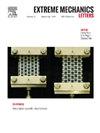局部相变和能量耗散诱发超薄金纳米片脆性断裂
IF 4.5
3区 工程技术
Q2 MATERIALS SCIENCE, MULTIDISCIPLINARY
引用次数: 0
摘要
具有面心立方(fcc)结构的金属,如金(Au),通常以其优异的延展性而闻名。然而,在这项研究中,我们观察到超薄金纳米片的脆性断裂行为,厚度约为15 nm,对角线长度高达80 μm,通过水溶液法合成。在这些纳米薄片上进行的纳米压痕实验显示出一种独特的断裂模式,其特征是裂纹以压痕点为120°角扩展。分子动力学(MD)模拟复制了这种不寻常的行为,将其归因于在外部应力作用下从fcc到六方密排(hcp)结构的局部相变。我们假设这种相变是由纳米片制备过程中引入的层错引起的。观察到的脆性断裂进一步受到能量耗散机制的影响,在断裂部位周围形成滑动线。我们的研究结果表明,即使在像Au这样的延展性金属中,由于局部相变和能量耗散,脆性断裂也可能发生。该研究为超薄金纳米片的力学行为提供了新的见解,对其在纳米电子学和其他先进技术中的应用具有重要意义。本文章由计算机程序翻译,如有差异,请以英文原文为准。
Brittle fracture of ultrathin gold nanosheets induced by local phase change and energy dissipation
Metals with a face-centered cubic (fcc) structure, such as gold (Au), are generally known for their excellent ductility. However, in this study, we observed a novel brittle fracture behavior in ultrathin Au nanosheets with a thickness of approximately 15 nm and a diagonal length of up to 80 μm, synthesized via an aqueous solution method. Nanoindentation experiments on these nanosheets revealed a unique fracture pattern, characterized by crack propagation at angles of 120° from the indentation point. Molecular dynamics (MD) simulations replicated this unusual behavior, attributing it to a localized phase transformation from the fcc to hexagonal close-packed (hcp) structure under external stress. We hypothesize that this phase transition is initiated by stacking faults introduced during the nanosheet fabrication process. The observed brittle fracture is further influenced by an energy dissipation mechanism, as evidenced by the formation of slip lines around the fracture site. Our findings suggest that even in ductile metals like Au, brittle fracture can occur due to localized phase changes and energy dissipation. This study provides new insights into the mechanical behavior of ultrathin Au nanosheets, with implications for their application in nanoelectronics and other advanced technologies.
求助全文
通过发布文献求助,成功后即可免费获取论文全文。
去求助
来源期刊

Extreme Mechanics Letters
Engineering-Mechanics of Materials
CiteScore
9.20
自引率
4.30%
发文量
179
审稿时长
45 days
期刊介绍:
Extreme Mechanics Letters (EML) enables rapid communication of research that highlights the role of mechanics in multi-disciplinary areas across materials science, physics, chemistry, biology, medicine and engineering. Emphasis is on the impact, depth and originality of new concepts, methods and observations at the forefront of applied sciences.
 求助内容:
求助内容: 应助结果提醒方式:
应助结果提醒方式:


